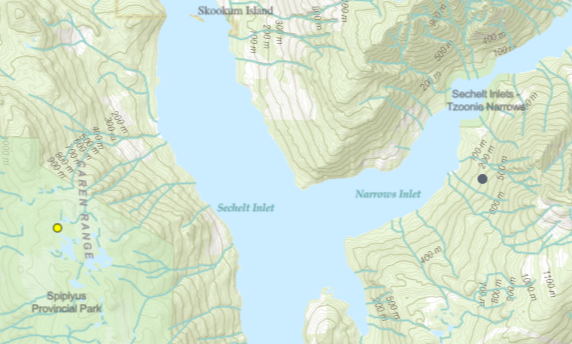Update: 4:00 p.m. Aug. 20
Fire V52278 in Sechelt Inlet has been extinguished.
Update: 12:10 p.m. Aug. 20
As of 12:02 p.m. fire V52283 (Narrows Inlet) has been extinguished.
Update: 10:30 a.m. Aug. 20
The status of all three fires has been updated as local BC Wildfire Service crews respond.
Fires V52276 (Hallowell FSR) and V52278 (Sechelt Inlet) are now being held and Fire V52283 (Narrows Inlet) is under control.
BCWS explained this means responders on site are confident the fires will not spread based on current conditions, the predicted weather pattern coming and the resources being allocated towards the fires.
Update 3:25 p.m. Aug. 19
A third spot fire has been discovered in the area, also suspected to have been caused by lightning. Fire V52283 was spotted on the southern side of Narrows Inlet. The small fire is listed as being held, meaning it is expected to stay within its current perimeter based on surrounding fuel and weather conditions.
Original story
Two, small wildfires on the lower Sunshine Coast are suspected to have been ignited during recent lightning strikes on the weekend.
Fires V52276 in the Hallowell FSR at Spipiyus Provincial Park and V52278 near Kunechin Point in Sechelt inlet were both discovered on Aug 18 and are listed as “out of control”, meaning a fire perimeter has not been established and there is a chance it will spread.
Both fires are listed as 0.0009 hectares in size by BC Wildfire Service (BCWS), designating them as “spot fires,” the smallest size they can assign.
BCWS explained these generally range from one to 10 square meters and include other small fires, such as trees struck by lightning.
While the cause is not yet confirmed, they noted the pattern of lightning that passed through the area in the last few days.
After lightning strikes, BCWS will send out flights to assess the area, gather more accurate data and search for other fires.
Conditions must be right for assessment flights to go out, the cloud ceiling needs to be high enough and there cannot be any risk of further thunderstorms, so it will be a few days until they can be sent out.
BCWS are not ones to sit idly due to weather – in the coming days, they said ground teams consisting of firefighters and responders will be sent out to assess the fires and plan a response.
Jordan Copp is the Coast Reporter’s civic and Indigenous affairs reporter. This reporting beat is made possible by the Local Journalism Initiative.



